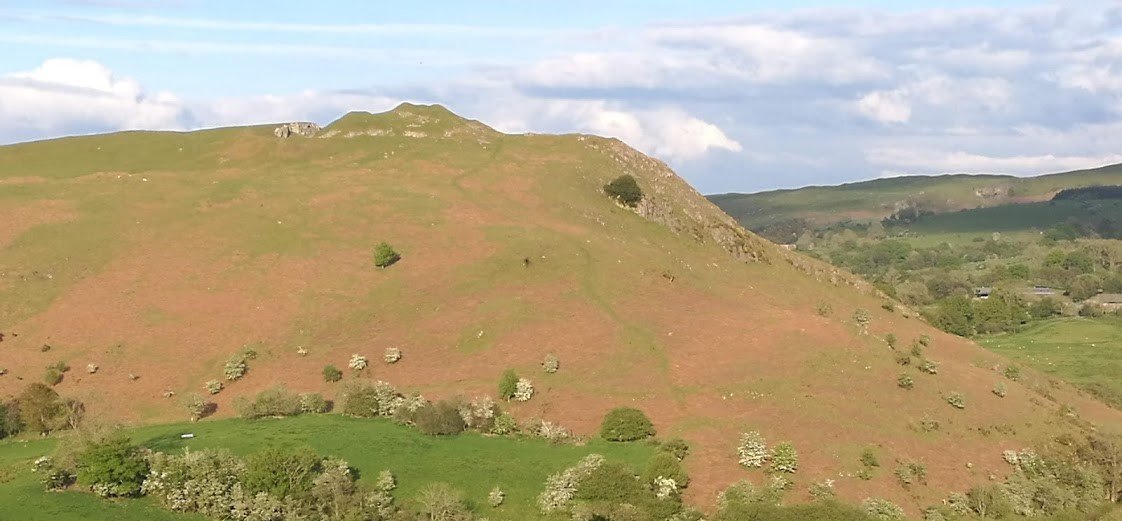History
Coety Bach is situated overlooking the Ithon Valley, near to the village of Penybont and is approximately 15 minutes drive from the Victorian Spa town of Llandrindod Wells.
Apart from its obvious close ties with agriculture, the Ithon Valley contains a rich heritage.
Cefnllys Castle or ‘Castle Hill’ as it is also known can be seen to the left of the Valley from the cabin. The 'castle' was actually two, built one after the other at opposite ends of the hill by the English lord Roger Mortimer of Wigmore during his battles with Llywelyn ap Gruffudd, Prince of Wales, for the cantref of Maelienydd.
The first, at the north end, was built in 1242 and ruined in 1262 by Llywelyn. The second, at the south end, was built in 1268 and survived Llywelyn's death, but was sacked by Cynan ap Maredudd during the revolt of Madog ap Llywelyn in 1294-5. It was ruined by 1588.
The medieval town of Cefnllys developed around St Michaels Church at the foot of ‘Castle Hill’ and was a contributory borough to the Radnor Boroughs constituency in the English and British parliament from 1542 until the Redistribution of Seats Act 1885. By 1831 however the town is said to have consisted of 3 farm houses and 1 cottage.
Located on the River Ithon, Penybont was the location of a turnpike on the main London to Aberystwyth road in the 19th century. Local farmers would gather to pay their tithes (taxes) and meet for various hunts at the local coaching Inn, the Severn Arms.
The grade II-listed Penybont Hall was built around 1755 by John Price and enlarged by his son-in-law J Cheesement Severn in 1818. In 1875 it was further enlarged and remodelled by his son J Percy Severn – hence the name of the local pub the ‘Severn Arms’ not the river. John Price and both the Severns were notable local gentry, all serving as High Sheriff of Radnorshire.
With its well-used Community Centre, Pub, Common, football club and the local attraction ‘The Thomas Shop’, Penybont is a thriving little village that is close knit and welcoming.
The spa town of Llandrindod at one point rivalled more illustrious places such as Tunbridge and Cheltenham, as the ‘place to be’ for the well-heeled Victorian emerging middle classes.
Saline and sulphur springs were discovered in the area during the 16th century, but it wasn’t until 1756 when Dr Wesel Linden published a scientific paper espousing the health benefits of ‘taking the waters’. Despite a degree of popularity the area didn’t flourish until the opening of the Central Wales railway line which connected Llandrindod to Knighton in 1865. This enabled people from the growing urban areas of the North West, Midlands and South Wales to visit the town and enjoy the health related benefits.
From 1865 to 1914 Llandrindod became something of a boom town with hotels, boarding houses, shops and grand scale houses being built. In 1871/2 an area of marshy land was drained to form a lake where it was fashionable to promenade. Churches, golf clubs and theatres were among many of the amenities that sprung up. However, the town’s spa industry declined steadily from the inter-war years to the 1970s.
The re-organisation of local government in 1974 resulted in Llandrindod being the County town for the newly established administrative county of Powys. This led to an influx of employees of the local bureaucracies and the establishment of ‘County Hall’ on Spa Road East.
In more recent years Llandrindod has returned to its tourism roots. With the advent of ‘staycations’, the increased awareness of the natural wonders of Wales and the development of outdoor pursuits, ‘Llandod’ is well placed to service the needs of visitors.


